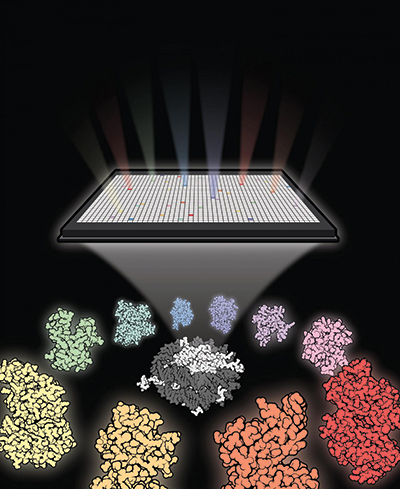JBC: Scanning thousands of molecules against an elusive cancer target
Researchers at the National Center for Advancing Translational Sciences, or NCATS, part of the National Institutes of Health, have developed a system to accelerate the discovery of chemical compounds that inhibit an enzyme implicated in a number of cancers. The tools and methods the researchers used to test more than 16,000 compounds are described in a paper published in the Journal of Biological Chemistry.
 A new study developed a set of methods to screen thousands of small molecules to find inhibitors of the cancer target NSD2.Matthew Hall/NCATS
A new study developed a set of methods to screen thousands of small molecules to find inhibitors of the cancer target NSD2.Matthew Hall/NCATS
The enzyme, NSD2, is overactive in cancers such as acute lymphoblastic leukemia and certain types of multiple myeloma, so inhibiting NSD2 activity seems like a promising strategy for treating those conditions. But so far researchers have not been able to find any chemicals that reliably block NSD2 even in a test tube in the laboratory, much less to test as drug candidates in living models.
“There’s a total lack of available chemical probes, druglike molecules, to help study (NSD2) function,” said Matthew Hall, the NCATS scientist who oversaw the new work.
It’s been difficult to discover chemical inhibitors of NSD2, in part, because the enzyme is difficult to work with in the laboratory. NSD2 modifies histones, the proteins around which DNA is wound. For technical reasons, scientists ordinarily would study this kind of activity using a fragment of the enzyme and a fragment of histone protein. But NSD2 works on only whole nucleosomes: units of histone protein in combination with DNA.
“(NSD2 and similar proteins) are very picky, because they prefer to only act on whole nucleosomes,” Hall said. “They’re snobby when it comes to what they’re willing to interact with.”
Collaborating with the biotechnology company Reaction Biology, Hall’s team, including lead author Nathan Coussens, developed laboratory tests involving whole nucleosomes that could be used to see whether NSD2 was able to modify histone proteins in the presence of various compounds. The compounds the team tested came from NCATS’s massive library of bioactive chemicals.
But finding a compound that appears to block NSD2 activity is only the beginning. To confirm that the chemicals identified in the initial massive screen were indeed bona fide inhibitors that would reliably and reproducibly perform this function in future researchers’ studies, the NCATS team needed to use multiple types of biochemical methods to confirm the activity of each compound.
“We screened 16,000 molecules, and we got 174 hits, but that doesn’t mean they all really work,” Hall said. “When we whittle away through the (additional screening methods), we get down to 44 molecules. You triage candidates out of your screen after you rigorously ask your molecule to prove itself to you.”
With several molecules now having proved themselves in this round of screening, Hall’s team hopes to continue the search for reliable NSD2 inhibitors that can be used as research tools and then, further down the road, possibly as medicines.
“We are in the process of planning to screen hundreds of thousands of molecules,” Hall said, “in order to find molecules that can be optimized for inhibition of NSD2 and disseminate these to the research community.”
Enjoy reading ASBMB Today?
Become a member to receive the print edition four times a year and the digital edition monthly.
Learn moreGet the latest from ASBMB Today
Enter your email address, and we’ll send you a weekly email with recent articles, interviews and more.
Latest in Science
Science highlights or most popular articles

Fueling healthier aging, connecting metabolism stress and time
Biochemist Melanie McReynolds investigates how metabolism and stress shape the aging process. Her research on NAD+, a molecule central to cellular energy, reveals how maintaining its balance could promote healthier, longer lives.

Mapping proteins, one side chain at a time
Roland Dunbrack Jr. will receive the ASBMB DeLano Award for Computational Biosciences at the ASBMB Annual Meeting, March 7–10, just outside of Washington, D.C.

Exploring the link between lipids and longevity
Meng Wang will present her work on metabolism and aging at the ASBMB Annual Meeting, March 7-10, just outside of Washington, D.C.

Defining a ‘crucial gatekeeper’ of lipid metabolism
George Carman receives the Herbert Tabor Research Award at the ASBMB Annual Meeting, March 7–10, just outside of Washington, D.C.

The science of staying strong
Muscles power every movement, but they also tell the story of aging itself. Scientists are uncovering how strength fades, why some species resist it and what lifestyle and molecular clues could help preserve muscle health for life.

Bacteriophage protein could make queso fresco safer
Researchers characterized the structure and function of PlyP100, a bacteriophage protein that shows promise as a food-safe antimicrobial for preventing Listeria monocytogenes growth in fresh cheeses.

.jpg?lang=en-US&width=300&height=300&ext=.jpg)